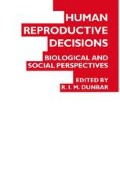Abstract
What reproductive strategies are favoured by natural selection in a world where wealth can be inherited? Heritable wealth introduces several interesting wrinkles. First, there is the trade-off between the number of one’s children and their wealth. A parent cannot simultaneously maximise both. Second, there is the question of how fitness should be defined. It makes no sense to equate fitness with the number of children, because the parent whose children are many may lose in competition with parents whose children are fewer but wealthier.
Preview
Unable to display preview. Download preview PDF.
References
Becker, G. S. (1981), A Treatise on the Family (Cambridge, MA: Harvard University Press).
Caswell, H. (1989), Matrix Population Models (Sunderland, MA: Sinauer).
Charlesworth, B. (1980), Evolution in Age-Structured Populations (Cambridge: Cambridge University Press).
Friedman, M. (1953), ‘The methodology of positive economics’, in M. Friedman (ed.), Essays in Positive Economics (Chicago: University of Chicago Press).
Harpending, H. C. and Rogers, A. R. (1990), ‘Fitness in stratified societies’, Ethology and Sociobiology, vol. 11, pp. 497–509.
Keyfitz, N. (1968) Introduction to the Mathematics of Population with Revisions (Reading, MA: Addison-Wesley).
Maynard Smith, J. (1982), Evolution and the Theory of Games (Cambridge: Cambridge University Press).
Pollak, R. A. (1990), Two-sex demographic models’, Journal of Political Economy, vol. 98, pp. 399–419.
Press, W. H., Flannery, B. P., Teukolsky, S. A. and Vetterling, W. T. (1988), Numerical Recipes in C: The Art of Scientific Computing (New York: Cambridge University Press).
Rogers, A. R. (1990), The evolutionary economics of human reproduction’, Ethology and Sociobiology, vol. 11, pp. 479–95.
Rogers, A. R. (1992), ‘Resources and population dynamics’, in E. Smith and B. Winterhaider (eds), Evolutionary Ecology and Human Behavior (Hawthorne, NY: Aldine de Gruyter) ch. 12.
Varian, H. R. (1984), Microeconomic Analysis (New York: W. W. Norton) 2nd edition.
Vining, D. R. (1986), ‘Social versus reproductive success — the central theoretical problem of human sociobiology’, Behavior and Brain Sciences, vol. 9, pp. 167–260.
Editor information
Editors and Affiliations
Copyright information
© 1995 The Galton Institute
About this chapter
Cite this chapter
Rogers, A.R. (1995). For Love or Money: the Evolution of Reproductive and Material Motivations. In: Dunbar, R.I.M. (eds) Human Reproductive Decisions. Studies in Biology, Economy and Society. Palgrave, London. https://doi.org/10.1007/978-1-349-23947-4_5
Download citation
DOI: https://doi.org/10.1007/978-1-349-23947-4_5
Publisher Name: Palgrave, London
Print ISBN: 978-1-349-23949-8
Online ISBN: 978-1-349-23947-4
eBook Packages: MedicineMedicine (R0)

